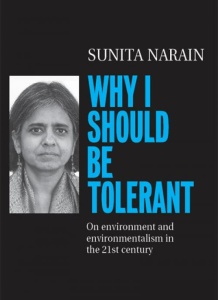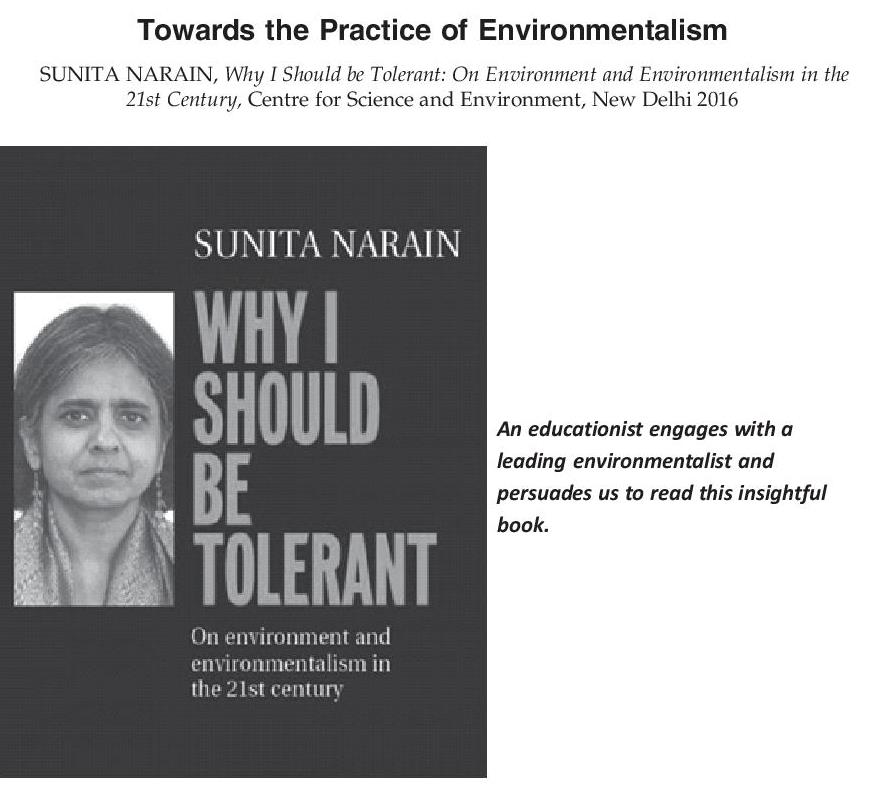BOOK REVIEW
Towards the Practice of Environmentalism
An educationist engages with a leading environmentalist and persuades us to read this insightful book.

SUNITA NARAIN, Why I Should be Tolerant: On Environment and Environmentalism in the 21st Century, Centre for Science and Environment, New Delhi 2016
REVIEW BY :
Dr. Ramanujam Meganathan is an associate Professor of English, National Council of Educational Research and Training (NCERT), New Delhi.
This is not yet another book on environment or environmentalism. It serves many a purpose–educating the environmentally educated and those who need to educate themselves on the crux of matters and problems in environmentalism and the discourses around it. Having been an insider to the problems and issues of environment and environmentalism over three decades, Sunita Narain brings out environment issues, problems, policy making and practices the contemporary world is aware of, but not willing to address for reasons known and chosen to tell us the more serious and much more imperative of environmental tolerance: the rich tolerating some of the environmentally unfriendly actions of the poor, and why poor nations need to come out of the good old argument that we also need to undergo the same process of wealth production as the West did; why the problem of drainage and toilet in urban India is not addressed, or why the governments don’t want to address them, and many more things. All said in a crisp manner. The merit of the essays lies in their succinctness and brevity. Somebody said it long ago, brevity is the soul of wit; this could be seen in every essay because no essay is more than three pages, and each telling its tales in depth. With the nine themes on environment— climate change, excreta, energy, governance, urbanization, air pollution, health, water and forest — Sunita makes a case for a comprehensive inclusive rethinking on environment and the need to reflect on the much debated issues on environmentalism. The one thread which runs all through the essays is the Western model of growth that the countries like India and China try to emulate. The author says in her preamble, “The Western model of growth that India and China most feverishly emulate is intrinsically toxic.” The essay titled, Two cities, two cultures is an eye opener for us when she presents the parallel of the Romans and the people of Edo (now the city of Tokyo). How Romans could not manage human waste which resulted in the destruction of rivers while the people of the Edo did manage their waste outside the city, far away from rivers and water bodies. She makes us understand that the Roman rivers are now mere history and archived for tourists, whereas Edo still lives on. So she says, “Today we are all children of Rome, not Edo.” No wonder, she adds, ‘Literally, no small or medium river today is clean. Every river that passes through a city or a town becomes a stinking sewer.’ None can deny this. The essay, ‘Why excreta matters.’ shows how the water you flush into your toilets (in cities) is robbing the waters of rivers, and what are sent back to the rivers are mere wastes making them drainages. ‘Coming generations will forget that the Yamuna, the Cauvery and the Damodar were rivers. They will know them as drains, only drains.’ This reminds us of Chennai’s Koovam—now a big drainage— which was a river hundred year ago. In fact, every essay makes us feel guilty of the ‘human acts’ which are detrimental to environment and will be dangerous to humans themselves. Unmindful use of natural resources and complete absence of any sign of concern cause a kind of degradation. This means, as Stephen Hawking writes, ‘fight for resources will be the final war on earth and between planets.’ He says that the earth is facing the danger of attacks from aliens who have exhausted all their resources in their planets and are looking for yet another earth like place to conquer. Sunita puts it rightly, “Today Indians take water from their rivers- for irrigation, drinking and power generation – and give back waste. Water no more flows in its rivers. It is the load of excreta and industrial effluent.” In one of the essays in the chapter, Urbanisation she discusses the ‘smart cities’ project of the present government. This, the author believes, will work only if it can reinvent the very idea of urban growth in a country like India. She further argues that our cities have been built to be car-free. We are now desperately shoving of, pushing and parking vehicles down the narrow lanes. Think Smart. Change the idea of mobility itself. Create spaces for walking, cycling, bus and metro. The chapter on Air Pollution has three essays, Cars, more cars; Lifeless on the fast lane; and The right right. All three of them deal with how our roads, particularly urban roads are functioning or used today. Citing the example of the city of Chennai which has seen 10 percent growth in population and a staggering 108 percent growth in on road private vehicles in the last decade, Sunita states that public transport in many cities caters to 50-70 per cent of commuters while private vehicles constitute over 90 percent of all vehicles. The story of Nano reveals how the subsidy which the government gives to cheap car production acts as a booster for people (who may not actually need) to buy cars. The question the author asks has to be answered, “Can the government write off the costs-Nano style- so that all can buy the car?” “Can the government pay for our parking, our roads and our fuels, so that all can drive the car?” This is the telling testimony of our reality to make India a ‘developed’ one. I still remember what Ramachandra Guha asked in his book, ‘How Much Should a Person Consume?’, “If everybody owns a car where will we have space to park them?” It is not that Sunita Narain is only provoking the people who matter in deciding some of the pertinent aspects of environment; she is also offering solutions to them. The chapter, Forests has the caption, If you alienate people from their habitats, you will only beget violence and lose productivity. The telling thing about the forest and people of the forest is letting them live in their forest. Managing and conserving forest is a burden on states, and states are no longer able or willing to afford. The statement, ‘Our forests are too important to be left unused and uncared for’ makes sense for a conservationist like Madhav Gadgil, and environmental historian Ramachandra Guha too advocates the same to protect our forests. Similarly the essay, Money does grow on trees makes a case for making use of the tress for productive purposes. The book makes us realize that we are all part and parcel of the crisis; and hence there are also possibilities of solutions in our own hands, if we reflect, introspect and initiate actions. As an educator, I feel this book is a must read for teachers, students, and university researchers. Most of the children study about the ill effects of the use of plastic bags and unmindful wastage of water; but they do use such items in the real life. This book will make a dent in their minds compelling them to think. It is also a must read for those who are at the healm of affairs. Moreover, the book should be read by those who believe that ‘urbanization alleviates poverty’. The question is: Can we make (from villages) move to cities (even smart cities) in the name of reducing poverty? This book while presenting the despair in environmental crisis still instills hope through practical actions. Finally, a word about the production of the book: great cover, readable print and the arrangement of essays based on well-defined themes. Sunita Narain conveys what she wants to convey and what needs to be conveyed. Let people listen to it.














